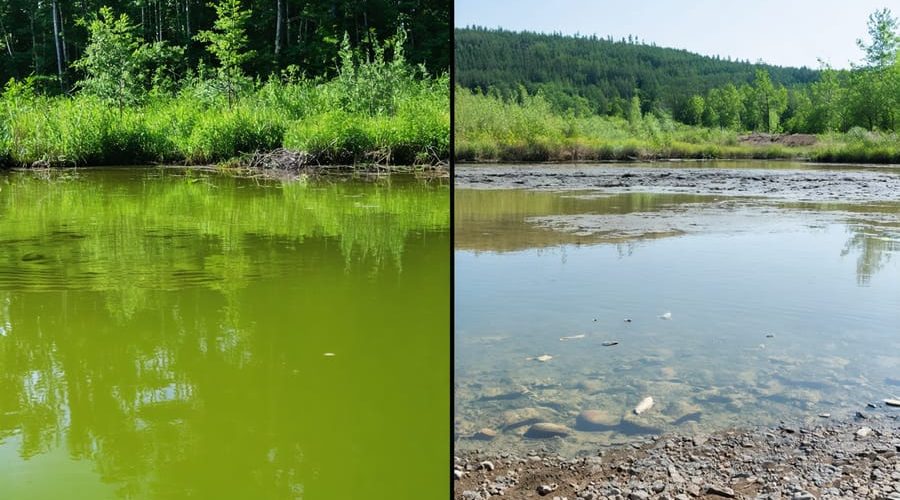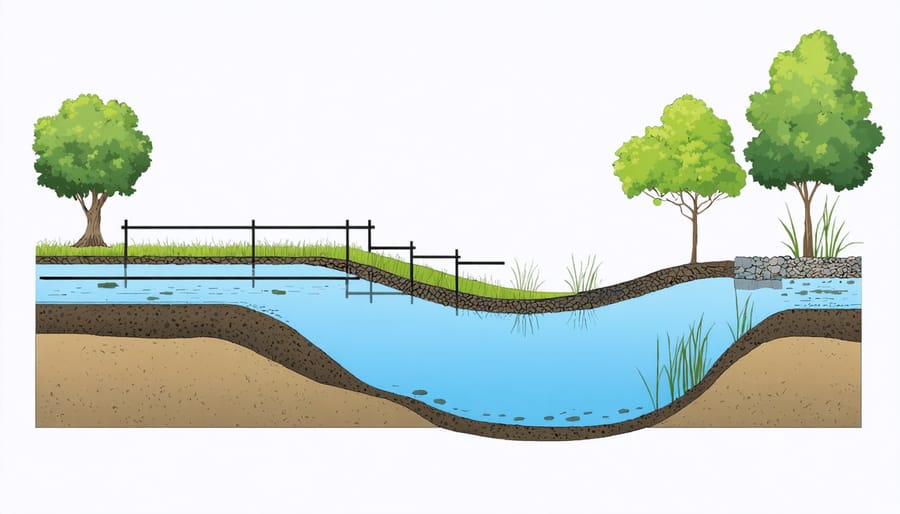
Protect Your Pond: Smart Solutions for Zinc Mining Runoff
Zinc mining operations near your pond require immediate protective measures to safeguard your water feature and its inhabitants. Acid mine drainage from zinc extraction can severely impact water quality, threatening fish health and disrupting the delicate balance of maintaining a healthy pond ecosystem. Common signs of mining contamination include increased water acidity, unusual algae growth, and declining fish activity. Regular water testing becomes crucial, focusing specifically on pH levels, heavy metal content, and dissolved oxygen. While large-scale mining operations may seem daunting, pond owners can implement practical solutions like installing buffer zones with native plants, implementing water filtration systems, and monitoring water quality weekly. Understanding these impacts empowers you to protect your pond investment and preserve its natural beauty, even with nearby mining activities.
Understanding Zinc Mining’s Impact on Water Systems
Common Zinc Mining Contaminants
Zinc mining operations typically release several concerning contaminants into the environment that can affect your pond’s ecosystem. The most common pollutants include heavy metals like cadmium, lead, and arsenic, which often occur alongside zinc deposits. Acid mine drainage is another significant issue, where sulfuric acid forms when mining exposes sulfide minerals to air and water, making water extremely acidic and harmful to aquatic life.
Suspended solids, such as dirt and rock particles, can cloud water and reduce oxygen levels. Mining operations also frequently release copper and iron, which can be toxic to fish and plants even in small amounts. Chemical processing agents used to extract zinc, including flotation chemicals and cyanide compounds, may leak into groundwater and surface water.
Selenium, though needed in tiny amounts by living organisms, becomes toxic at higher concentrations often found near mining sites. Nitrogen compounds from explosives used in mining can also contaminate water sources, potentially leading to algae blooms in ponds.
Signs of Mining-Related Water Contamination
If your pond is near a zinc mining area, watch for these telltale signs of contamination. The most obvious indicator is water color changes – look for unusual milky, cloudy, or rusty appearances. You might notice a metallic sheen on the water’s surface or white deposits along the pond edges.
Monitor your fish behavior closely. If they’re gasping at the surface, swimming erratically, or showing reduced activity, this could signal water quality issues. Plant health is another crucial indicator – watch for yellowing leaves, stunted growth, or dying vegetation.
Test your water regularly for pH levels. Mining contamination often makes water more acidic, with readings below 6.5. You may also detect unusual odors, particularly metallic or sulfuric smells. Keep an eye on water clarity – if you can’t see the bottom of your pond where you usually could, this might indicate contamination.
Watch for decreased wildlife activity around your pond, as birds and amphibians often avoid contaminated water sources.

Natural Filtration Solutions
Beneficial Plants for Heavy Metal Removal
Several beneficial aquatic plants can help naturally remove zinc and other heavy metals from water. Water hyacinth is a superstar in this regard, capable of absorbing significant amounts of zinc through its extensive root system. Duckweed, despite its small size, is another powerful metal remover that grows quickly and is easy to maintain.
Reed plants, particularly common reed (Phragmites australis), are excellent at filtering out zinc and other metals while adding visual interest to your pond. Cattails are not only beautiful but also highly effective at drawing out heavy metals through their roots. Water lilies serve a dual purpose – they’re gorgeous additions to any water feature while helping to reduce metal contamination.
For the best results, consider combining different species to create a natural filtering system. These plants not only help clean your water but also provide habitat for wildlife and add natural beauty to your pond. Remember to regularly harvest and properly dispose of these plants, as they’ll contain the absorbed metals.

Creating Natural Filter Zones
Creating effective natural water filtration systems around your pond can help protect it from zinc mining runoff. Start by identifying the natural slope and water flow patterns in your landscape. Plant wetland species like cattails, rushes, and water iris in graduated zones, beginning with moisture-loving plants nearest to the water source.
Create a series of shallow depressions or swales, each about 6-8 inches deep, lined with gravel and organic matter. Space these areas about 10 feet apart, allowing water to slow down and filter naturally through each zone. Add native grasses like switchgrass or Indian grass as your first line of defense, followed by deep-rooted perennials.
For best results, incorporate a mix of plants at different heights. Tall plants help trap larger particles, while shorter ground covers filter finer materials. Remember to maintain these areas by removing debris and trimming plants seasonally. This natural approach not only filters mining contaminants but also creates beautiful, wildlife-friendly spaces around your pond.
Technical Mitigation Strategies
Water Testing and Monitoring
Regular water testing is crucial for pond owners near zinc mining operations. Start by establishing a baseline for your water quality before any mining activity begins. Test for key parameters including pH levels, dissolved oxygen, total dissolved solids (TDS), and specific metals like zinc, lead, and copper.
Purchase a reliable water testing kit that can detect heavy metals, or consider sending samples to a certified laboratory quarterly. Pay special attention after heavy rains, as runoff from mining sites can significantly impact water quality. Keep detailed records of all test results to track changes over time.
Install continuous monitoring systems if possible, such as automated pH meters or conductivity sensors. These provide real-time alerts if water quality suddenly changes. Look for signs of potential contamination like unusual water color, dead fish, or declining plant health.
Create a regular testing schedule – weekly for basic parameters and monthly for comprehensive tests. Share your findings with local environmental agencies if you notice concerning trends. Remember, early detection of water quality issues is key to protecting your pond’s ecosystem and taking corrective action before serious problems develop.
Filtration System Options
Several effective filtration systems can help protect water sources from zinc mining contamination. Multi-stage mechanical filters are particularly useful, removing larger particles and sediments before they enter water systems. These typically include sand filters and activated carbon layers, which can capture up to 95% of heavy metal contaminants.
Ion exchange systems have proven highly effective against zinc and other metal pollutants, using specialized resins to trap harmful ions while releasing harmless ones. These systems are especially valuable for areas close to mining operations, as they can reduce zinc concentrations to safe levels.
Reverse osmosis (RO) systems offer another powerful solution, forcing water through a semi-permeable membrane that blocks most contaminants. While more expensive, RO systems can remove up to 99% of dissolved metals and other pollutants.
Natural filtration methods, such as constructed wetlands and biofilters, provide a more sustainable approach. These systems use specific plants and beneficial bacteria to naturally filter out zinc and other mining contaminants, though they require more space and time to establish effectiveness.
For best results, experts recommend combining multiple filtration methods in a comprehensive treatment system, creating multiple barriers against mining-related water pollution.

Preventive Measures
Barrier Systems
Physical barriers play a crucial role in preventing zinc mining contamination from affecting nearby water bodies and ecosystems. Common barrier systems include containment walls, underground seepage barriers, and strategically placed buffer zones. These barriers are typically constructed using a combination of clay liners, geomembranes, and engineered soil mixtures that effectively block contaminated water from spreading.
Buffer zones, consisting of natural vegetation and carefully selected plants, create an additional protective layer between mining operations and surrounding areas. These zones not only filter pollutants but also help stabilize soil and reduce erosion. Many mining operations implement multi-layered barrier systems that combine physical structures with natural filtration methods.
Regular monitoring and maintenance of these barrier systems is essential, as any breach could lead to serious environmental consequences. Modern barrier designs often incorporate sensor technology to detect potential leaks or structural weaknesses before they become major issues.
Runoff Management
Mining operations must carefully manage runoff to prevent zinc-contaminated water from affecting nearby water bodies and ecosystems. Common control measures include constructing settling ponds and detention basins that allow contaminated sediments to settle before water is released. Diversion channels and berms redirect surface water away from mining areas, while specialized drainage systems collect and treat contaminated water.
Modern mines often implement sophisticated water treatment systems that use lime addition to precipitate dissolved metals and adjust pH levels. Wetland filtration systems can provide natural treatment, using specific plants that absorb and filter out heavy metals. Regular water quality monitoring ensures these systems function effectively.
To prevent acid mine drainage, mines seal exposed rock surfaces and carefully manage waste rock piles. Covers and liners prevent rainwater from contacting potentially acid-generating materials. These measures, combined with proper maintenance and emergency response plans, help protect local water resources from mining-related contamination.
Protecting our environment from the impacts of zinc mining requires a balanced approach combining responsible mining practices, strict environmental monitoring, and community involvement. Regular water quality testing, soil analysis, and wildlife population assessments are essential to track and minimize negative effects. Mining companies must maintain transparent communication with local communities and implement the latest pollution control technologies. As pond owners and gardening enthusiasts, we can contribute by reporting any unusual changes in water quality and participating in local environmental monitoring programs. Remember, successful environmental protection is a shared responsibility that benefits everyone – from mining operators to local residents and wildlife. By staying informed and actively involved in environmental protection efforts, we can help ensure that zinc mining operations coexist harmoniously with our natural spaces and water features for generations to come.
